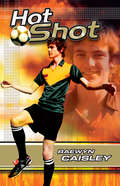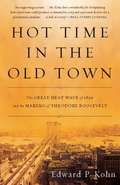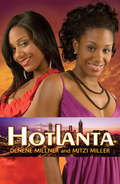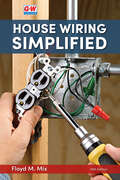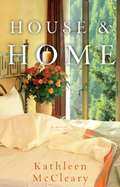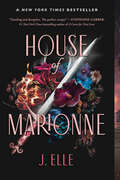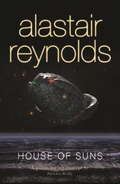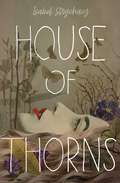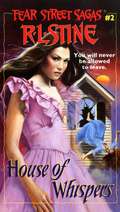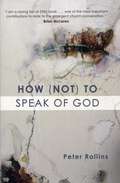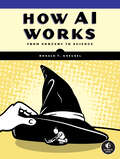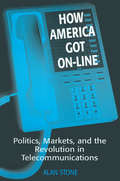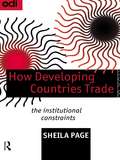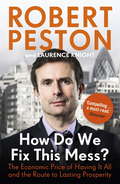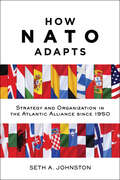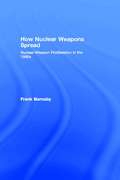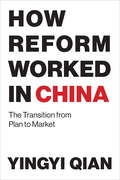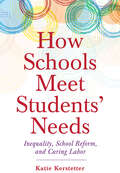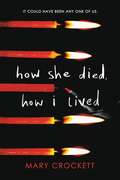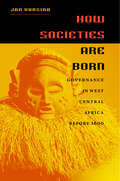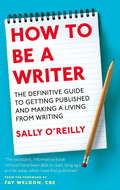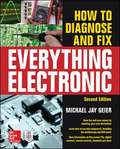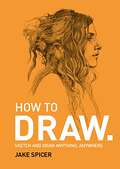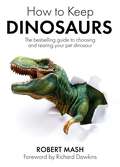- Table View
- List View
Hot Shot
by Raewyn CaisleyHow did Harry Kewell do it? That?s what Sam wants to know. How did he handle being called a `hot shot? by his team-mates? Sam bets Harry?s coach never benched him for winning the game single-handedly! And what about Harry?s dad? Did he think soccer was for sissies too? Things are getting too tough for Sam to handle, until he meets Manuel Luque, an ex-professional English soccer player. At last there?s someone on his side! But even though Manuel?s got the contacts, the news isn?t all good. Just what does it take for a young Aussie soccer star to realise his dream? From Raewyn Caisley, the acclaimed and established author of TOP MARKS, NOT CRICKET, IN UNION, TENNIS STAR, FREE STYLE and GREAT LEAD, comes another book in the popular Junior Sports Series.
Hot Time in the Old Town: The Great Heat Wave of 1896 and the Making of Theodore Roosevelt
by Edward P. KohnOne of the worst natural disasters in American history, the 1896 New York heat wave killed almost 1,500 people in ten oppressively hot days. The heat coincided with a pitched presidential contest between William McKinley and the upstart Democrat William Jennings Bryan, who arrived in New York City at the height of the catastrophe. As historian Edward P. Kohn shows, Bryan’s hopes for the presidency began to flag amidst the abhorrent heat just as a bright young police commissioner named Theodore Roosevelt was scrambling to mitigate the dangerously high temperatures by hosing down streets and handing out ice to the poor. A vivid narrative that captures the birth of the progressive era, Hot Time in the Old Town revives the forgotten disaster that almost destroyed a great American city.
Hotlanta: Book 1 (Hotlanta #1)
by Mitzi Miller Denene MillnerDesigner clothes. Gorgeous boys. Family secrets. Major drama. Welcome to Atlanta and the lives of the Duke twins, Sydney and Lauren. They don't call it Hotlanta for nothing!The Duke twins, Sydney and Lauren, live the life: They attend the fanciest school in Atlanta, they live in Buckhead, the most exclusive neighborhood, and they only date the hottest guys. And their secrets? Are the darkest of all. When their estranged father is released from prison and a murder is committed, their lives are plunged into a whirlwind of tabloid scrutiny, vicious gossip, and shocking revelation. Lauren, always such a party girl, and Sydney, bent on perfection by way of the Ivy League, can't trust anyone. Not their mother, not their rich stepfather. Maybe not even each other.
House Wiring Simplified
by Floyd M. MixHouse Wiring Simplified presents fundamental, safe installation information and procedures, enhanced by the inclusion of easy-to-understand drawings. This short text is the perfect resource for a residential electricity module included in comprehensive construction programs. Content covers wiring in both older and newer homes. This text also includes details on how to determine what wiring is needed and what equipment and materials to use. Color-coded diagrams aid in the explanation of various types of circuits.
House and Home
by Kathleen McClearyThe story of a woman who loves her house so much that she'll do just about anything to keep it. Ellen Flanagan has two precious girls to raise, a cozy neighborhood coffee shop to run, terrific friends, and a sexy husband. She adores her house, a yellow Cape Cod filled with quirky antiques, beloved nooks and dents, and a million memories. But now, at forty-four, she's about to lose it all. After eighteen roller-coaster years of marriage, Ellen's husband, Sam--who's charismatic, spontaneous, and utterly irresponsible--has disappointed her in more ways than she can live with, and they're getting divorced. Her daughters are miserable about losing their daddy. Worst of all, the house that Ellen loves with all her heart must now be sold. Ellen's life is further complicated by a lovely and unexpected relationship with the husband of the shrewish, social-climbing woman who has purchased the house. Add to that the confusion over how she really feels about her almost-ex-husband, and you have the makings of a delicious novel about what matters most in the end. . . . Set in the gorgeous surroundings of Portland, Oregon, Kathleen McCleary's funny, poignant, curl-up-and-read debut strikes a deep emotional chord and explores the very notion of what makes a house a home.
House of Marionne (House of Marionne #1)
by J. ElleAn INSTANT New York Times bestseller!An INSTANT USA TODAY bestseller!An INSTANT Sunday Times bestseller! A modern-day YA romantic fantasy series opener about a glamorous magical world of social elites, forbidden love, and a dark magic that could destroy it all. "Dazzling and deceptive. The perfect escape!" – Stephanie Garber, #1 New York Times bestselling author of The Ballad of Never After"The forbidden love story of my wildest dreams!" – Ali Hazelwood, New York Times bestselling author of The Love HypothesisBURY YOUR SECRET OR DIE FOR IT.17-year-old Quell has lived her entire life on the run. She and her mother have fled from city to city in order to hide the deadly magic that flows through Quell&’s veins. Until someone discovers her dark secret.To hide from the assassin hunting her and keep her mother out of harm&’s way, Quell reluctantly inducts into a debutante society of magical social elites called the Order that she never knew existed. If she can pass their three rites of membership, mastering their proper form of magic, she&’ll be able to secretly bury her forbidden magic forever. If caught, she will be killed.But becoming the perfect debutante is a lot harder than Quell imagined, especially when there&’s more than tutoring happening with Jordan, her brooding mentor and assassin-in-training. When Quell uncovers the deadly lengths the Order will go to defend its wealth and power, she&’s forced to choose: Embrace the dark magic she&’s been running from her entire life, or risk losing everything, and everyone, she&’s grown to love.Still, she fears the most formidable monster she&’ll have to face is the one inside.Brimming with ballgowns and betrayal, magic and mystery, decadence and darkness, House of Marionne is perfect for readers who crave morally gray characters, irresistible romance, dark academia, and a deeply intoxicating and original world.
House of Suns
by Alastair ReynoldsA spectacular, large-scale space opera - the ultimate galaxy-spanning adventureSix million years ago, at the very dawn of the starfaring era, Abigail Gentian fractured herself into a thousand male and female clones: the shatterlings. Sent out into the galaxy, these shatterlings have stood aloof as they document the rise and fall of countless human empires. They meet every two hundred thousand years, to exchange news and memories of their travels with their siblings.Campion and Purslane are not only late for their thirty-second reunion, but they have brought along an amnesiac golden robot for a guest. But the wayward shatterlings get more than the scolding they expect: they face the discovery that someone has a very serious grudge against the Gentian line, and there is a very real possibility of traitors in their midst. The surviving shatterlings have to dodge exotic weapons while they regroup to try to solve the mystery of who is persecuting them, and why - before their ancient line is wiped out of existence, forever.
House of Thorns
by Isabel StrychaczIn the vein of The Haunting of Hill House, a teen returns to the mysterious house from her past to search for her missing sister and uncover the truth of Brier Hall in this atmospheric and eerie modern gothic novel.Lia Peartree is haunted—by memories, by her past, by secrets, by the ones she left behind. Five years ago, the Peartrees fled their home—the infamous ancestral Brier Hall—and never looked back. But her oldest sister went missing that night, and there&’s been no sign of her since. In the aftermath, the Peartrees are traumatized and get by however they can. Lia&’s remaining sister Ali says yes to any bad idea, and Lia tries so desperately to be the perfect daughter that it&’s tearing her apart. But as the five year anniversary of the night they left nears, Lia begins seeing her missing sister everywhere, and memories of Brier Hall won&’t leave her alone. When Ali disappears with no warning except a cryptic phone call—&“don&’t follow me when I&’m gone&”—Lia is sure she&’s gone back to Brier Hall. Lia must go home one final time and face what haunts her in an effort to find her sisters and uncover the truth of her past.
House of Whispers: A New Fear; House Of Whispers; Forbidden Secrets (Fear Street Saga #2)
by R.L. StineAmy Pierce knows nothing of the terrifying Fear history when she arrives for a visit with Simon and Angelica Fear. Their New Orleans mansion is beautiful—but Amy senses something evil there. Something that watches her. Waits for her. Will Amy be strong enough to escape the powers controlled by the Fear family?
How (Not) to Speak of God
by Peter RollinsWith sensitivity to the Christian tradition and a rich understanding of postmodern thought, Peter Rollins argues that the movement known as the "emerging church" offers a singular, unprecedented message of transformation that has the potential to revolutionize the theological and moral architecture of Western Christianity.How (not) to Speak of God sets out to explore the theory and praxis of this contemporary expression of faith. Rollins offers a clear exploration of this embryonic movement and provides key resources for those involved in communities that are conversant with, and seeking to minister effectively to, the needs of a postmodern world. "Here in pregnant bud is the rose, the emerging new configuration, of a Christianity that is neither Roman nor Protestant, neither Eastern nor monastic; but rather is the re-formation of all of them. Here, in pregnant bud, is third-millennium Christendom." —Phyllis Tickle "I am a raving fan of the book you are holding. I loved reading it. I have already begun widely recommending it. Reading it did good for my mind and for my soul. It helped me understand my own spiritual journey more clearly, and it gave me a sense of context for the work I'm involved in. In fact, I would say this is one of the two or three most rewarding books of theology I have read in ten years." —Brian McLaren, from the Foreword
How AI Works: From Sorcery to Science
by Ronald T. KneuselAI isn&’t magic. How AI Works demystifies the explosion of artificial intelligence by explaining—without a single mathematical equation—what happened, when it happened, why it happened, how it happened, and what AI is actually doing "under the hood."Artificial intelligence is everywhere—from self-driving cars, to image generation from text, to the unexpected power of language systems like ChatGPT—yet few people seem to know how it all really works. How AI Works unravels the mysteries of artificial intelligence, without the complex math and unnecessary jargon.You&’ll learn: The relationship between artificial intelligence, machine learning, and deep learningThe history behind AI and why the artificial intelligence revolution is happening nowHow decades of work in symbolic AI failed and opened the door for the emergence of neural networksWhat neural networks are, how they are trained, and why all the wonder of modern AI boils down to a simple, repeated unit that knows how to multiply input numbers to produce an output number.The implications of large language models, like ChatGPT and Bard, on our society—nothing will be the same againAI isn&’t magic. If you&’ve ever wondered how it works, what it can do, or why there&’s so much hype, How AI Works will teach you everything you want to know.
How America Got On-line: Politics, Markets, and the Revolution in Telecommunication
by Alan StoneThe telecommunications industry is the fastest growing sector of the US economy. This interdisciplinary study of technopolitical economics traces the industry's evolution from the invention of the telephone to the development of hypercommunications. Primary focus is on AT&T and its rivals.
How Developing Countries Trade: The Institutional Constraints
by Sheila PageOver the last fifteen years there have been dramatic increases in both private and public intervention in international trade. Traditional barriers to market-based trade such as commodity cartels and tariffs have been augmented by new developments such as the rise of regional trade blocs and the growth of intra-firm trade. This book argues that the
How Do We Fix This Mess?
by Robert PestonIn Robert Peston's new book he explains in his characteristically straightforward way how the world got itself into the current economic mess - and how we might get out of it. 'How do we fix this mess? I don't know. But don't stop reading now. Perhaps if we have a clearer understanding of what went wrong, we'll have a better idea of what needs to be done. This book is a map of what needs to be fixed.' The record-breaking unbroken growth between 1992 and 2008 wasn't the economic miracle that it seemed. It was based on a number of dangerous illusions - most notably that it didn't matter that the UK and US year after year consumed more than they earned. But we couldn't go on increasing our indebtedness forever. The financial crash of 2007/8 and the subsequent economic slump in much of the west was the moment when we realised we had borrowed more than we could afford to repay. So who got it wrong? Bankers, investors and regulators? And were they greedy, stupid or asleep? What was the role of government? And what part did we, as consumers, play in all this? How do we get through this difficult period of transition to a more sustainable economy, one based on investment and exports, rather than on borrowing and consumption? With the same probing lucidity he brought to WHO RUNS BRITAIN?, Robert Peston takes us step-by-step towards a common sense way to fix this mess.
How NATO Adapts: Strategy and Organization in the Atlantic Alliance since 1950 (The Johns Hopkins University Studies in Historical and Political Science #132)
by Seth A. JohnstonDespite momentous change, NATO remains a crucial safeguard of security and peace.Today’s North Atlantic Treaty Organization, with nearly thirty members and a global reach, differs strikingly from the alliance of twelve created in 1949 to "keep the Americans in, the Russians out, and the Germans down." These differences are not simply the result of the Cold War’s end, 9/11, or recent twenty-first-century developments but represent a more general pattern of adaptability first seen in the incorporation of Germany as a full member of the alliance in the early 1950s. Unlike other enduring post–World War II institutions that continue to reflect the international politics of their founding era, NATO stands out for the boldness and frequency of its transformations over the past seventy years.In this compelling book, Seth A. Johnston presents readers with a detailed examination of how NATO adapts. Nearly every aspect of NATO—including its missions, functional scope, size, and membership—is profoundly different than at the organization’s founding. Using a theoretical framework of "critical junctures" to explain changes in NATO’s organization and strategy throughout its history, Johnston argues that the alliance’s own bureaucratic actors played important and often overlooked roles in these adaptations. Touching on renewed confrontation between Russia and the West, which has reignited the debate about NATO’s relevance, as well as a quarter century of post–Cold War rapprochement and more than a decade of expeditionary effort in Afghanistan, How NATO Adapts explores how crises from Ukraine to Syria have again made NATO’s capacity for adaptation a defining aspect of European and international security. Students, scholars, and policy practitioners will find this a useful resource for understanding NATO, transatlantic relations, and security in Europe and North America, as well as theories about change in international institutions.
How Not to Disappear
by Clare FurnissA pregnant teen and her gin sling loving great-aunt go on the journey of a lifetime in this &“absolutely gorgeous, heartfelt, and incredibly enjoyable&” (Robin Stevens, author of Murder Most Unladylike) novel that shows what happens when you&’re on the brink of losing everything.Our memories are what make us who we are. Some are real. Some are made up. But they are the stories that tell us who we are. Without them we are nobody. Hattie&’s summer is not going according to plan. Her two best friends have abandoned her: Reuben has run off to Europe to &“find himself&” and Kat is in Edinburgh with her new girlfriend. Meanwhile Hattie is stuck babysitting her twin siblings and dealing with the endless drama surrounding her mother&’s wedding. And she&’s also just discovered that she&’s pregnant with Reuben&’s baby. Then Gloria—Hattie&’s great-aunt who no one even knew existed—comes crashing into her life. Gloria&’s fiercely independent, rather too fond of a gin sling, and is in the early stages of dementia. Together the two of them set out on a road trip of self-discovery—Gloria to finally confront the secrets of her past before they are erased from her memory forever and Hattie to face the hard choices that will determine her future.
How Nuclear Weapons Spread: Nuclear-Weapon Proliferation in the 1990s
by Frank BarnabyIn How Nuclear Weapons Spread, Frank Barnaby examines the far-reaching effects - both beneficial and detrimental - of nuclear weapons. He looks in detail at the nuclear programmes of Third World countries, including India, Israel and Pakistan which have or could very rapidly acquire nuclear weapons, and assesses the nuclear capabilities of countries such as Iran, Iraq and North Korea. He also considers the alarming possibility that terrorists might obtain nuclear weapons, and considers methods of controlling their spread.
How Reform Worked in China: The Transition from Plan to Market
by Yingyi QianA noted Chinese economist examines the mechanisms behind China's economic reforms, arguing that universal principles and specific implementations are equally important. As China has transformed itself from a centrally planned economy to a market economy, economists have tried to understand and interpret the success of Chinese reform. As the Chinese economist Yingyi Qian explains, there are two schools of thought on Chinese reform: the “School of Universal Principles,” which ascribes China's successful reform to the workings of the free market, and the “School of Chinese Characteristics,” which holds that China's reform is successful precisely because it did not follow the economics of the market but instead relied on the government. In this book, Qian offers a third perspective, taking certain elements from each school of thought but emphasizing not why reform worked but how it did. Economics is a science, but economic reform is applied science and engineering. To a practitioner, it is more useful to find a feasible reform path than the theoretically best way. The key to understanding how reform has worked in China, Qian argues, is to consider the way reform designs respond to initial historical conditions and contemporary constraints. Qian examines the role of “transitional institutions”—not “best practice institutions” but “incentive-compatible institutions”—in Chinese reform; the dual-track approach to market liberalization; the ownership of firms, viewed both theoretically and empirically; government decentralization, offering and testing hypotheses about its link to local economic development; and the specific historical conditions of China's regional-based central planning.
How Schools Meet Students' Needs: Inequality, School Reform, and Caring Labor (Critical Issues in American Education)
by Katie KerstetterMeeting students’ basic needs – including ensuring they have access to nutritious meals and a sense of belonging and connection to school – can positively influence students’ academic performance. Recognizing this connection, schools provide resources in the form of school meals programs, school nurses, and school guidance counselors. However, these resources are not always available to students and are not always prioritized in school reform policies, which tend to focus more narrowly on academic learning. This book is about the balancing act that schools and their teachers undertake to respond to the social, emotional, and material needs of their students in the context of standardized testing and accountability policies. Drawing on conversations with teachers and classroom observations in two elementary schools, How Schools Meet Students’ Needs explores the factors that both enable and constrain teachers in their efforts to meet students’ needs and the consequences of how schools organize this work on teachers’ labor and students’ learning.
How She Died, How I Lived
by Mary Crockettp.p1 {margin: 0.0px 0.0px 0.0px 0.0px; font: 13.0px Times} Girl in Pieces meets The Way I Used to Be in this poignant and thought-provoking novel about a girl who must overcome her survivor's guilt after a fellow classmate is brutally murdered. I was one of five. The five girls Kyle texted that day. The girls it could have been. Only Jamie--beautiful, saintly Jamie--was kind enough to respond. And it got her killed. On the eve of Kyle's sentencing a year after Jamie's death, all the other "chosen ones" are coping in various ways. But our tenacious narrator is full of anger, stuck somewhere between the horrifying past and the unknown future as she tries to piece together why she gets to live, while Jamie is dead.Now she finds herself drawn to Charlie, Jamie's boyfriend--knowing all the while that their relationship will always be haunted by what-ifs and why-nots. Is hope possible in the face of such violence? Is forgiveness? How do you go on living when you know it could have been you instead?
How Societies Are Born: Governance in West Central Africa before 1600
by Jan VansinaLike stars, societies are born, and this story deals with such a birth. It asks a fundamental and compelling question: How did societies first coalesce from the small foraging communities that had roamed in West Central Africa for many thousands of years?Jan Vansina continues a career-long effort to reconstruct the history of African societies before European contact in How Societies Are Born. In this complement to his previous study Paths in the Rainforests, Vansina employs a provocative combination of archaeology and historical linguistics to turn his scholarly focus to governance, studying the creation of relatively large societies extending beyond the foraging groups that characterized west central Africa from the beginning of human habitation to around 500 BCE, and the institutions that bridged their constituent local communities and made large-scale cooperation possible.The increasing reliance on cereal crops, iron tools, large herds of cattle, and overarching institutions such as corporate matrilineages and dispersed matriclans lead up to the developments treated in the second part of the book. From about 900 BCE until European contact, different societies chose different developmental paths. Interestingly, these proceeded well beyond environmental constraints and were characterized by "major differences in the subjects which enthralled people," whether these were cattle, initiations and social position, or "the splendors of sacralized leaders and the possibilities of participating in them."
How To Be A Writer: The definitive guide to getting published and making a living from writing
by Fay Weldon Sally O'ReillyHow To Be a Writer is a comprehensive guide to the career of writing from experienced writer and creative writing tutor Sally O'Reilly.The book will cover questions such as: If you want to be a writer, should you invest in a creative writing course? If so, which one? Are writing groups a good thing? What grants, awards and prizes are available to the aspiring writer? How should you plan your career in the long term? It will also feature an introduction from Fay Weldon - 'Why I wish I'd read this book when I was 25' - and will include comments and case studies from other established authors, agents and industry experts. How To Be a Writer will include everything that a writer needs to know about running their own career, from choosing an agent to café scribbling, and from filing a tax return to flirting with the literati and will be an essential reference book for any author who takes their work seriously.
How To Diagnose And Fix Everything Electronic
by Michael Jay GeierRepair all kinds of electrical products, from modern digital gadgets to analog antiques, with help from this updated book. How to Diagnose and Fix Everything Electronic, Second Edition, offers expert insights, case studies, and step-by-step instruction from a lifelong electronics guru. Discover how to assemble your workbench, use the latest test equipment, zero in on and replace dead components, and handle reassembly. Instructions for specific devices, including stereos, MP3 players, digital cameras, flat-panel TVs, laptops, headsets, and mobile devices are also included in this do-it-yourself guide. Choose the proper tools and set up your workbench Ensure personal safety and use proper eye and ear protection Understand how electrical components work and why they fail Perform preliminary diagnoses based on symptoms Use test equipment, including digital multimeters, ESR meters, frequency counters, and oscilloscopes Interpret block, schematic, and pictorial diagrams Disassemble products and identify sections Analyze circuits, locate faults, and replace dead parts Re-establish connections and reassemble devices
How To Draw: Sketch and draw anything, anywhere with this inspiring and practical handbook
by Jake SpicerJake Spicer wants you to learn how to draw. This is his complete course in drawing, suitable for complete beginners as well as experienced artists, and designed to help you fit drawing into your lifestyle. Tried-and-tested exercises, ranging from five-minute sketches to dedicated sessions of an hour or longer, cover every subject and location you could wish for, while accessibly written drawing theory helps you relate the technical concepts to your practice, helping you to hone your craft. Whatever your goals are, expert art tutor Jake Spicer gives you the inspiration and encouragement to draw more - and keep improving.
How To Keep Dinosaurs: The perfect mix of humour and science
by Robert Mash'Who could resist a handbook about potential pets that has a little symbol for "likes children" and a separate one for "likes children to eat"... wonderful' GUARDIANHollywood and the popular press would have us believe that all dinosaurs are gigantic, hostile and untameable. In fact, there are many species that make charming and even useful companions: Velociraptor - a splendid, loyal, fierce, friendDeinonychus - will not eat dog food (dogs are another matter)Tyrannosaurus - least suitable to keep; will need special licenceOrnithomimus - an appealing first dinosaur for the child anxious for her first rideThis book advises you which dinosaur is right for you and your home, from the city apartment dweller looking for a lap pet, to the country estate owner looking to tighten up on security. HOW TO KEEP DINOSAURS is a bestselling guide, packed with the sort of information keen dinosaur keepers crave - from feeding and housing to curing common ailments, breeding and showing your animal. The author, a zoologist with extensive experience of dinosaurs, has provided a timely and much-needed source book for all those who keep dinosaurs and for the huge numbers who are contemplating getting one. It is as essential to every dinosaur keeper as a stout shovel and a tranquilliser rifle.
